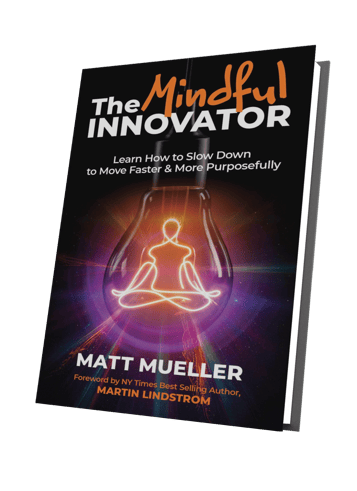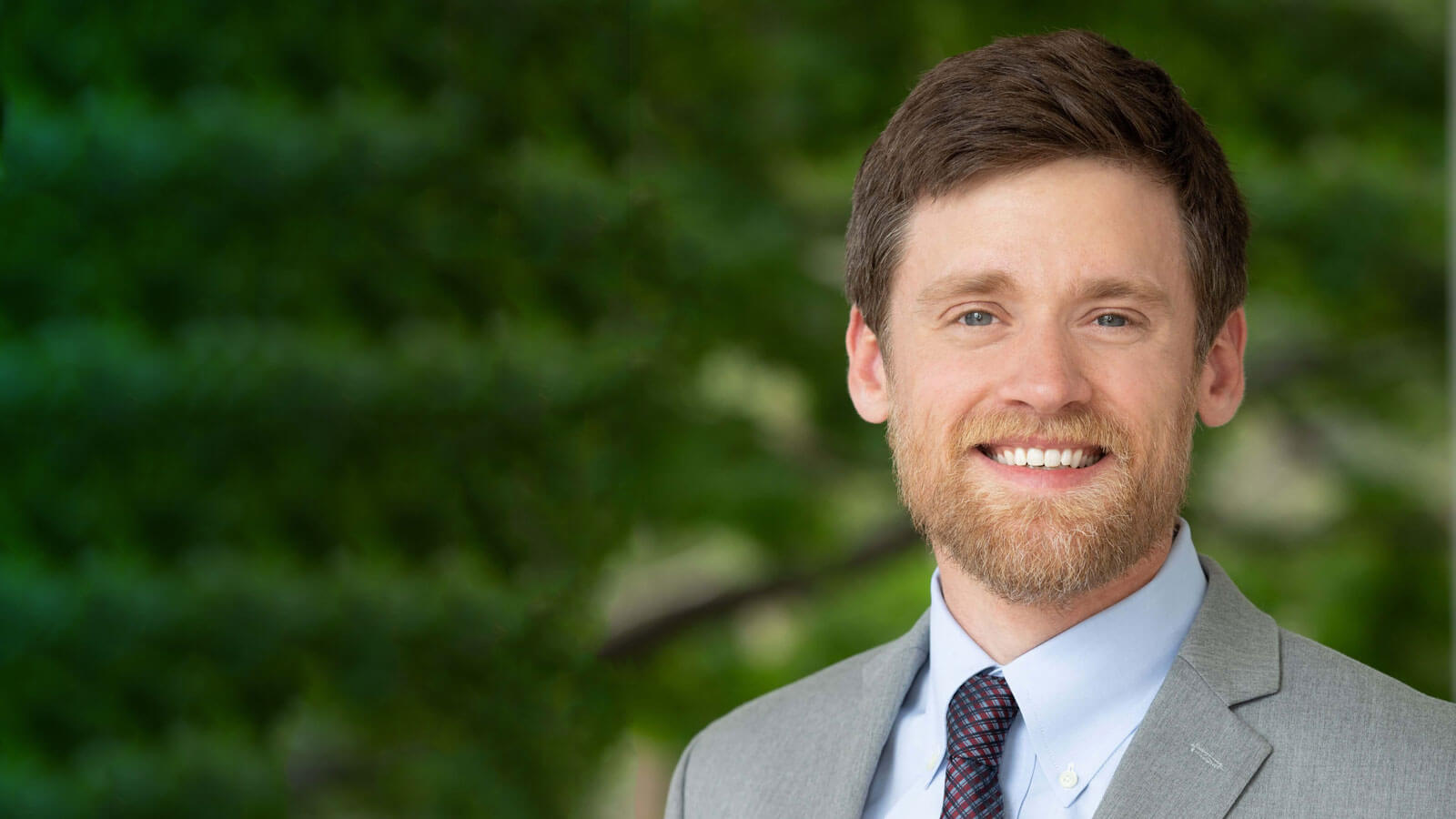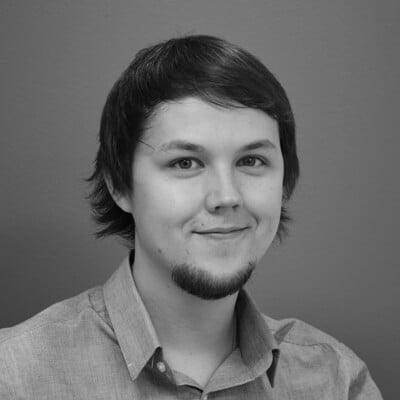Defining Problems in the Innovation Process with Matt Mueller
We’re continuing our series of interviews with innovation experts. This time we’re interviewing Matt Mueller about the importance of problem definition. Why do we fail to define them and why should we slow down in the innovation process?
Matt is an innovation consultant, columnist, speaker, and author with over a decade of experience in executing strategy and facilitating change for some of the world’s largest consumer packaged goods brands and retail stores.
Table of contents
Could you tell our listeners more about yourself and your background?
Matt: Even before I had a professional journey, I’ve always been fascinated by how leaders like Martin Luther King Jr., JFK, Mother Teresa create change. What made them different than the other 8 billion people in the world, what made them create change? There are so few leaders like them out there. That was my base as a child.
So, when I got my first job working in a deli behind the counter helping customers, I quickly got to management, and I immediately tried to figure out how I can create change at work. I would do experiments with my team to try and create a better consumer experience. What if I were to incentivize my employees, what if I were to provide guidance and structure for them, what if we would have fun, what if I would mentor them? I would try out all these different things on a monthly basis to create the best consumer experience that I possibly could. How can I drive change?
From there I moved on from retail to the corporate side of the business and I worked on retail support. There I tried to create change by looking at the kind of data insights I could provide to my leaders to show the direction we needed to go and the reason to change. This then led me right into a role within innovation, making a change with innovation, innovating in product and innovating in the retail experience, and innovating in operations. So, that's what brought me to where I am today, sharing my experience from innovation with the world.
This year, 2023 started on a positive note for you. You've published a book “The Mindful Innovator. Learn how to slow down, to move faster and more purposefully”. What inspired you to write this book?
Matt: Well, it's a book that I wish I read a decade ago when I started in innovation.
When I first went to the corporate side of the business, I would go in early every single morning and do my data insights. I would love to go in at 6:00 AM just because it was nice and quiet. This one Friday I go in at 6:00 o'clock in the morning, get my hot coffee, sit at my desk, fire up my computer, and my phone rang, which was strange. My phone doesn't usually ring at 6:15 in the morning. I pick it up and it's one of the executives of our company saying, hey Matt, I want to talk to you, can you come up and have a conversation?
I wasn't sure if I should pack my personal belongings, but I went up to the executive suite, I press the button in the elevator, my palms are sweating and I am thinking, what's going on right now? Why are we having this conversation? I go into his office, and he says, Matt, we're looking to create an innovation team, and we think that you would be one of the people that can help us start this team, we want to figure out how can we innovate as a company.
I was surprised, why me? At the time, it didn't make sense. I have no MBA, I don't have classical training in innovation. So, how does that make any sense? I was very overwhelmed and apprehensive. But this is innovation, so, of course, I said yes, I'll do it. Who would say no to an innovation job? It just sounded so neat.
I took the position, and I went home and told my family about it. I was so excited. I would dream about what I'll be doing in innovation: building robots, adding lasers to the experience, and AI and VR and every other acronym I could think of. It was all about tech. I was reading different books about philosophies and processes that we can use, like design thinking and stage gate. I was using all these different things in my daily practice, and I would feel like they're good, but that we don't really get too far with them. Nothing was really taking off for us early on.
And that's when I realized that we were, looking up at innovation. What I mean by that, is that we think about innovation as rocket science. It's pretentious. It's very hard to do. Not everyone can do it, only a couple of us can. Then I realized that we need to look down on innovation.

Innovation is stupid. It's, super easy to do. And we just have to have that mindset that anyone can innovate. And you know what? It's true. Anyone can. If we just think about it a little bit simpler. Don't worry about adding high tech to every single thing that you're doing; it's not what innovation is about. And that's the book I wish I had when I first started and why I wrote it.
Innovation is stupid. It's super easy to do.
Mindfulness, which is at the core of your book, is a phrase that I personally do not stumble upon often when I read about innovation.
Matt: That's why I wrote the book. I could not find anything about mindfulness.
Thinking about innovation and why you don't hear about it is because of the culture. Look at the mantras that we have – innovate or die, fail fast, disrupt, or be disrupted. It sets a fast-paced culture. Things need to get done now and immediately.
If we think of COVID-19 and how the industry reacted, it only exacerbated the situation that we have with this innovation culture, that we need to do right now.
At the time, I was working on innovation, trying to create the best retail experience possible for our consumers. When COVID hit, everything changed, and like everybody else, we pivoted. We had to do something else, and it was all about creating a safe experience in retail and that's fair.
In week one, we're thinking to clean/disinfect all the different boxes and products that are coming into the store because of the safety measures. A week later we learn that it wasn't important.
We pivoted again thinking that we need UV lights, to get all the surface areas clean. We learned that that's not really that important either. Let's pivot again, and again and then again. Well, when you keep on pivoting over and over again, what's happening? You're going in a circle. You're going nowhere fast, and it's just very dizzying.
I had the same experience with the dizzying effect when I got my first smartphone. I was just enthralled with it; I would be on it all day long. I'd be text messaging, making phone calls, sending emails, using social media, checking notifications – consuming every piece of content I could on the Internet.
It was everything to me. And I couldn't wait till my phone buzzed again to get that next dopamine hit. It was dizzying and I, like a lot of other people, used mindfulness to get out of that world and be able to become present, back into the moment of everyday life and not have to worry about our phone so much.
So, the thought was, when we think about innovation, if I get that same dizzying effect as I was with my smartphone why not use mindfulness for innovation? It makes total sense.
Quite often innovators get trapped in the cycle of doing for the sake of doing, they lose the purpose. Why do you think this happens? Why we're not able to see the problem?
Matt: I mean, innovation is cool, right? It's just a really cool topic and it demands our attention. It demands consumers' attention because people want innovation in their lives. It demands the attention of investors. And it also gets demand from people within a company because it provides them hope that things are going to get better.
So, innovation is just an amazing word that gets people's attention. Brands know this so, they have to leverage the word innovation and that really waters down the whole industry.
Innovation is just an amazing word that gets people's attention. And brands know this. And so, they have to leverage the word innovation and that really waters down the whole industry.
Think about Apple. They have a meeting once a year, a convention where they talk about their newest, latest, and greatest products. That event usually costs them $50 million.
In 2019, they launched their Apple Seven Series Watch. This was the big announcement of that year, and people stopped in their tracks and watched it in the middle of the day. People just stopped and – I am not going to work anymore. I got to watch this video. Hold on. I got to see what they're going to be saying.
The big innovation of the watch was that the screen grew 5 millimeters in size, and it had a beveled edge. Is that really innovation? They spent $10 million per millimeter to announce that they increased the size of the watch. That doesn't make sense to me. That's not innovation, that's an incremental change to a product, but it has minimal impact, and it does not solve a consumer problem. It's not impacting anybody's life.
That's where innovation falls into the trap where of “innovating” just to generate more revenue for the following year. It’s no longer about innovating, it's about revenue and marketing. That's where innovation loses purpose.
How do you get unstuck from these traps?
Matt: I mean, everyone falls into those traps, everybody. I've never seen it not happen.
One of the traps that I fell into was early on in my innovation career. I would go to conferences all over the country in the US to learn new things, network with people, see new processes, new products, and other interesting things.
I went to an event in New York City, for retail displays. I saw a lot of cool things like augmented reality, VR, three-dimensional signs, and automated replenishing displays.
I saw this one display that really caught my eye. It was a three-dimensional sign that looked just like a flat sign and all of a sudden, it started moving in another direction as I was moving. It was like those baseball cards that have a hologram inside.
It wasn’t only three-dimensional, but it also had an animation piece to it. Imagine if it was a BBQ, you would actually see the smoke rising from the grill. I found this really interesting, and I thought that this might help me solve a problem that I'm facing at work – trying to get people to look at my signs and stores. So, maybe this will create attention. Let's do it. Let's start working on this project.
I spent quite a few months working on this, developing the technology with the vendor. We put it into stores, it was awesome looking, just like seeing the product three-dimensional with animation.
We started testing it out and we learned really quickly that consumers didn't look at it. The reason why? It's still a sign. They don't care. They don't want to look at a sign. So, what I was trying to do is to solve my own problem. I was trying to solve the problem of “I need consumers to look at my sign”. I wasn't looking at it from the viewpoint of my consumer, that they need a reason to look at my sign. What purpose can that sign provide for them? What problem can that sign solve for the consumer to make them look at it?
I was completely trapped in the same exact thing I mentioned when talking about Apple. Like everyone else – we look at our own problems and think that this is what we need to solve.
No, we have to look at it from the consumer's point of view and look at things in that direction. Going to those shows usually causes those types of traps of OK, how do I deploy this solution into a problem that's a force fit, and it doesn't really exist?
We look at our own problems and think that this is what we need to solve. No, we have to look at it from the consumer's point of view and look at things in that direction.
Weeks ago, when we spoke for the first time, you mentioned the story of the Thirsty Dog. How does this relate to the topic of finding and defining problems?
Matt: Thirsty Dog was a company created in the late 90s by a Florida man, Marc Duke. He created this company because he saw a huge problem that he faced: he did not like to give his beagle tap water. The reason was that tap water has chlorine, and other minerals that might not be safe for his dog. He thought that he had to give his dog premium water. So why not create water for dogs, spring water that has the right flavor profile for them?
He designed his whole company around it. He tested it with around 5000 dogs. He created these waters with different flavors, tested them out, and learned that crispy beef water was perfect for dogs. They absolutely loved it – 95% of them would absolutely want to drink that water. He started selling to grocery stores all across the US.
He did good the first couple of months. He sold a lot to grocery stores, and pet stores. But when the water was on the shelf, nobody was buying it. And the reason why was because dogs don't have wallets, they can't buy water.
He tested this product out with dogs and of course, they're going to like it – it's crispy beef! What dog is not going to like that? But consumers were not seeing the same problem that Marc Duke was seeing. They did not think that drinking tap water was dangerous. And what was scary about the whole company was that this was based on one man's problem. He had signs along the way that told him that it wasn't a real problem, but he ignored it.

He would have a veterinarian say, you know what, this is an old-time elixir and it's not really something that's going to work, it's like snake oil, and it's not going to be better for your dog, I wouldn’t do it.
Mark's response to it was that he saw a problem, and he thought his dog will like it. That was his reasoning behind it. He would talk to hundreds of people, and they would tell him that their dogs drink from toilets and they don't see an issue with it. If they're drinking from a toilet, they wouldn’t be buying bottled water for their dogs. And his response to them usually was “would you drink from the toilet?” I mean, it has nothing to do with bottled water versus tap water! His logic just wasn't working because he was biased.
It was a real passionate problem for him that created a bias that made him blind to everything else, not seeing every other consumer and not seeing it became an issue.
What is the top lesson you’ve learned on defining problems from all your years of experience?
Matt: What you really need to think about is splitting yourself in half. Half of you needs to be soft, and the other half of you needs to be hard.
When you're talking to an innovation user, your consumer, maybe it's someone within your company that needs to use your service or product you need to be soft. And what I mean by that is that we need to take everything in, remove our bias, and remove what we know.
I might be in the industry for 20 years, but it doesn't matter. I know nothing. If you come with that viewpoint of knowing nothing and your user knows everything, you start to take in their point of view.
Look at them as the experts, learn from them, understand what their problems are, and understand what their motivations are to really make sure that you are doing right by your innovation’s end user.
At the same time, the other side of you needs to be hard. This hard side is looking at your leadership and your executive team, your stakeholders. By hard, I mean that a lot of times we will get this “hey, I think that we need to change and pivot from creating a better service experience to a more convenient experience, that's what really matters to consumers”.
You need to be able to say no, that is not what we need to do. And be able to give evidence of why that is. I know that could be very difficult for many, especially for a lot of junior people moving in. You don't want to tell the owner of a company or the CEO of a company that no, we can't do this. But the thing is that you are close to the innovation process, and you are the one listening to the point of view of your users. You have to have their back and to make sure that you're looking at them and saying to your executive team, that actually the 95% of conversations that we have had with consumers told me that they are focused on service.
What is the data that you can point to that proves why you're doing the things you're doing, why they make sense, and why you don't need to pivot? Make sure that you are hard and push back. The executive team will thank you for it in the future. Otherwise, you're going to be pivoting in circles the whole time. Make sure that you are soft for your users and hard for your executive team.
Do you think that we need processes in innovation?
Matt: We can't just hug a tree and meditate and think that we're going to innovate. You can't do that. You have to have some type of process or philosophy behind it all. But you have to make sure that that's not leading the way.
We can't be leading with design thinking because design thinking is cool, that's what I learned, and I want to use it. That's really what it comes down to. It's just stripping everything down first, to understand, OK, what is my real problem and how can I create change here and how can I get people to accept that change? And then, once you figure that out, you can think about what tools I need from my toolbox that can help me along the way.
If I have a really big project that I'm working on, that's going to be billions of dollars or maybe millions of dollars, I might want to stage gate that because I don't want to spend all that money upfront. I want to see, what I can learn in stage one, stage two, stage three.
So, looking at what is it going to take for people to accept it. This innovation may make you look at what processes you're going to use and when you're going to use them. It makes you more purposeful about pulling something out of that toolbox rather than just always using it because that's what innovation is.
Do you have any favorite methodologies, tools, or techniques that you like to use to pinpoint the problem in the innovation process?
Matt: To find the real problem – ethnography. And that's my methodology of choice. Getting into the weeds with consumers and going into their homes or working alongside a person that you're innovating for, is so eye-opening.

I sat on couches with consumers to learn about their eating habits and talked to them about their daily life at home and what they eat. They'll tell you things like, “I eat very healthy, and only organic food.” Then we go take a look into their refrigerator and we'll see that they have Oscar Mayer baloney and other things. Then I would ask, “I thought you ate all organic” and they would answer that that’s for a day that they are really busy, and they don't have time, sort of a shortcut.
During those ethnographies, learning from your consumer is my favorite methodology for really understanding what the real problem is. That's my go-to.
Is ethnography something that a small company could use too?
Matt: Absolutely! And it comes down to that point of being soft, right? The whole approach to ethnography is to be the novice. Ask questions. Be curious. Talk to your consumers.
A company of one can go and learn from their consumers, from their users. What their motivations and what their real problems are just by talking to them. It's all about being open and spending time with them. You could do it regardless of the company’s size, even on your own, without paying a big firm to do it. To add to that, don't seed in your bias. Don't lead with questions that you already know the answer to or want them to say. Don't lead the witness. Just ask very broad questions and let them come up with the answers.
If you were to ask them if they have a problem with school lunches, they might say, “Yes, I have a problem with school lunches”. You don't want to go at it straight on. You want to be able to ask questions like – “what are some of the biggest concerns you have for your children?” When you do it that way it opens up the door for an answer you seek to come out. Or not. And it might not come out and you have to be OK with that.
Is there any kind of antidote to biases?
Matt: I would first start with reading the book, the Mindful Innovator. I think that's a perfect place to start because there are great tips in the book that help you remove that bias.
What I try and do, and it is mentioned in the book, is to understand if the problem is real. It comes down to meditation.
Calm down a little bit, just sit down, relax, turn everything off for a few minutes, and be with yourself, just focus on your breath. I would focus on my breathing for 5 minutes and start breathing in and breathing out. Just creating calmness and solitude. Once I get there, I really start to reflect on that problem.
When we get to questioning ourselves repeatedly, we could then uncover if that problem is real.
When we start looking at all those layers of evidence, we then start to really be able to question ourselves and our own motivations and see our own bias. It just comes down to slowing down and reflecting. It's not complicated. It's not like you have this really complicated process. It's just stopping for a minute and reflecting and thinking about whether this truly is a real problem.
If you'll continually pivot, in the end, you’ll realize it was wrong. If we just slow down to think truly through the whole situation, we can move faster and more purposefully.
If you would have to pick one thing that you would like our listeners and readers to take away from this conversation, what would it be?
Matt: I guess it'll be a personal lesson that I learned over the last few years.
The book that I just wrote took me 4 years to write. It wasn't because I didn't have the content or thoughts. It wasn't because I was a slow typer. It was because I doubted myself and I feared what people would think, that they're not going to pay attention, they're not going to listen to me. But after one month of launching, I have gotten so much great feedback and outreach, and people are telling me that it is truly helping them to reflect on their situation and helping them realign with their purpose. That made me so happy.
It also made me realize that the leaders that I looked up to as a child, like Martin Luther King Jr., John F Kennedy, all of them, the whole time they were doing just that – they were aligned with their purpose, to create great change in the world.
It made me realize that if we just slow down, become more aware of our own actions, and our own environment, and reach a level of awareness in every conversation, every observation, and every moment – we can all be mindful innovators. Innovating faster and more purposefully. Just be aware of what you are doing. That one piece of advice will change everything.
If we just slow down and become more aware of our own actions, and our own environment – we can all be mindful innovators.
Interested in Innovation and Leadership?
Join 90k+ other monthly readers and subscribe to our blog to get the latest stories on innovation, leadership and culture straight to your inbox.


.png?width=50&height=50&name=Untitled%20design%20(1).png)




